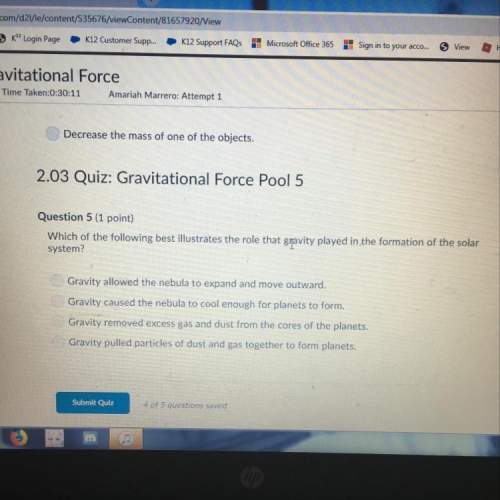(1) a piece of clear glass
(2) a snowball
(3) a shiny mirror
(4) a black sweater
...

Chemistry, 04.03.2021 05:00 nalanisancruzado
(1) a piece of clear glass
(2) a snowball
(3) a shiny mirror
(4) a black sweater
10. During which phase change is heat energy absorbed by a substance? *
1 point
Captionless Image
1) liquid to gas
(2) gas to solid
(3) liquid to solid
(4) gas to liquid
11. Which example best demonstrates the process of conduction? *
1 point
(1) A piece of paper is torn in half.
(2) Warmed air rises above a lit candle.
(3) A metal spoon gets warm when used to stir hot soup.
(4) Sunlight brightens a dark room.
12. The diagram below shows a Bunsen burner heating a beaker of water on a beaker stand. The arrows represent the transfer of heat energy in the water. Which process is primarily responsible for the transfer of heat indicated by the arrows in the beaker of water? *
1 point
Captionless Image
1) conduction
(2) convection
(3) radiation
(4) condensation
13. The graph below shows the heating curve for substance X. At approximately which temperature does a phase change begin? *
1 point
Captionless Image
(1) −30°C
(2) −10°C
(3) 0°C
(4) 18°C
14. In a convection current, hot air will rise because it is *
1 point
(1) less dense
(2) more dense
(3) cooler
(4) a better insulator
15. Energy from the Sun reaches Earth mainly by the process of *
1 point
(1) conduction
(2) convection
(3) reflection
(4) radiation
16. The diagram below shows a model of a sample of gas particles at room temperature. Which diagram best shows the results of removing heat from this sample until it freezes? *
1 point
Captionless Image
Option 1
Option 2
Option 3
Option 4
17. The illustration below shows a solid metal ball and a ring before and after heat is applied to the metal ball. Before heat is applied, the metal ball passes easily through the ring. After heat is applied, the metal ball does not pass through the ring. Why does this occur? *
1 point
Captionless Image
The heat causes a chemical change and makes the particles in the ball contract.
The heat causes a physical change and makes the particles in the ball contract.
The heat causes a physical change and makes the particles in the ball expand.
The heat causes a chemical change and makes the particles in the ball expand.
18. Ice changes to liquid water during which process? *
1 point
(1) dissolving
(2) melting
(3) evaporation
(4) condensation
19. The diagram below shows two insulated Styrofoam cups of water connected by an aluminum bar. The thermometers show the temperature of the water in cup A and cup B at the beginning of a heat-flow experiment. Over the next 15 minutes, which changes would most likely occur? *
1 point
Captionless Image
The temperature in cup A will decrease and temperature in cup B will increase.
The temperature in cup A will decrease and the temperature in cup B will decrease.
The temperature in cup A will increase and the temperature in cup B will increase.
The temperature in cup A will increase and the temperature in cup B will decrease.
20. Which process is most responsible for the temperature changes that will take place? *
1 point
Captionless Image
radiation of heat from the water in the cups to the thermometers
conduction of heat through the aluminum bar
radiation of heat from the water in the cups into the air
conduction of heat through the air to the water in the cups
21. A substance has a freezing point of -38 degrees Celsius and a boiling point of 356 degrees Celsius. At what temperature would this substance be in its liquid state? *
1 point
-100 degrees Celsius
-50 degrees Celsius
80 degrees Celsius
375 degrees Celsius
22. A wet shirt is put on a clothesline to dry on a sunny day. The shirt dries because water molecules *
1 point
gain heat energy and condense
gain heat energy and evaporate
lose heat energy and condense
lose heat energy and evaporate

Answers: 3


Other questions on the subject: Chemistry

Chemistry, 22.06.2019 05:30, jameskarbar9p8c9d2
Match the following vocabulary terms to their definitions. 1. amount of energy required to change 1 gram of material from the solid to the liquid state at its melting point 2. a measure of the kinetic energy of the particles of a substance 3. the amount of heat energy required to raise the temperature of 1 gram of liquid water from 14.5°c to 15.5°c 4. amount of energy required to change 1 gram of material from the liquid to the gaseous state at its boiling point 5. the amount of energy required to change 1 gram of a substance 1°c a. temperature b. latent heat of vaporization c. latent heat of fusion d. calorie e. specific heat
Answers: 1



Chemistry, 22.06.2019 12:20, jessicasbss6840
Adeuteron, 21h, is the nucleus of a hydrogen isotope and consists of one proton and one neutron. the plasma of deuterons in a nuclear fusion reactor must be heated to about 3.02×108 k . what is the rms speed of the deuterons? express your answer using two significant figures.
Answers: 1
You know the right answer?
Questions in other subjects:


Mathematics, 12.02.2021 01:00

Chemistry, 12.02.2021 01:00

Mathematics, 12.02.2021 01:00









